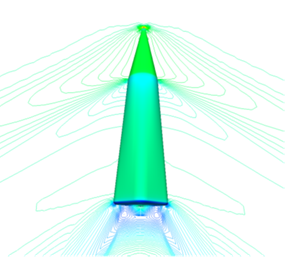Study on the reusable launch vehicle
JAXA Supercomputer System Annual Report April 2016-March 2017
Report Number: R16E0072
- Responsible Representative: Hiroyuki Ogawa(The institute of space and astronautical science, Department of Space Flight Systems)
- Contact Information: Takashi Ito(ito.takashi@jaxa.jp)
- Members: Takashi Ito, Masamichi Nakamura
- Subject Category: Space(Rocket,Space transportation)
Abstract
The small reusable launch vehicle demonstrator will be developed by utilizing the JAXA’s past advanced technologies such as reusable sounding rocket technical demonstration project and the component and system level studies related to future reusable systems. The demonstrations will be focused on life management technology on propulsion systems, fault tolerant system, vertical takeoff and landing system, and aerodynamically vehicle controlled system to obtain the competitive advantage from the other related projects. The new technologies obtained in these activities will be applied to the future flagship mission to develop the large launch vehicle systems.
Goal
To prevent the widening disparity between Japan and US in the reusable launch vehicle technology, system level studies are carried out at JAXA.
Objective
The system level demonstration on vertical lift off and landing, quick turnaround operation will be carried out under similar flight conditions using the small demonstrator.
References and Links
N/A
Use of the Supercomputer
Numerical investigation on the aerodynamic coefficient on reusable launch vehicle demonstrator
Necessity of the Supercomputer
The reduction on wind tunnel testing will be possible
Achievements of the Year
Mach number distributions on the flow field (M=1.5) and pressure distributions on the vehicle body is shown in Fig.1. The computation is carried out assuming the ascent phase of the trajectory. The negative base pressure produces the large drag. The engine plume is not computed in the current simulation for simplicity and we are preparing to carry out more advanced computation by introducing actual flight conditions in the future.
Publications
N/A
Computational Information
- Parallelization Methods: Process Parallelization
- Process Parallelization Methods: MPI
- Thread Parallelization Methods: n/a
- Number of Processes: 144
- Number of Threads per Process: 1
- Number of Nodes Used: 12
- Elapsed Time per Case (Hours): 8
- Number of Cases: 5
Resources Used
Total Amount of Virtual Cost(Yen): 319,754
Breakdown List by Resources
| System Name | Amount of Core Time(core x hours) | Virtual Cost(Yen) |
|---|---|---|
| SORA-MA | 50,273.16 | 82,686 |
| SORA-PP | 2,173.23 | 18,555 |
| SORA-LM | 0.01 | 0 |
| SORA-TPP | 0.00 | 0 |
| File System Name | Storage assigned(GiB) | Virtual Cost(Yen) |
|---|---|---|
| /home | 481.61 | 4,543 |
| /data | 19,578.94 | 184,688 |
| /ltmp | 2,929.69 | 27,635 |
| Archiving System Name | Storage used(TiB) | Virtual Cost(Yen) |
|---|---|---|
| J-SPACE | 0.53 | 1,645 |
Note: Virtual Cost=amount of cost, using the unit price list of JAXA Facility Utilization program(2016)
JAXA Supercomputer System Annual Report April 2016-March 2017



